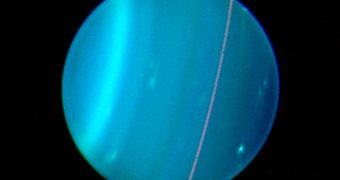According to the conclusions of a new scientific study, it would appear that Uranus got such a tilted orbit after being subjected to repeated impacts from comets. In the past, astronomers believed that only a single, devastating blow was sufficient to tilt the massive gas giant.
In addition to providing a better understanding of the current configuration Uranus displays, experts are now also able to make better predictions about what went on in the early solar system, when planets were just forming, the Sun was just a fraction of its current age.
Furthermore, astronomers argue that the new proposal also explains why the planet's moons are also tilted at such high angle. Understanding how the 4 gas giants formed, moved and evolved is critical to gaining a deeper insight into the current configuration of the solar system.
Conducting such studies is a very complex task, seeing how every bit of information needs to be squeezed through laborious studies. The only sources of information are the remaining celestial bodies themselves, along with their scars and peculiarities.
“The standard planet formation theory assumes that Uranus, Neptune and the cores of Jupiter and Saturn formed by accreting only small objects in the protoplanetary disk,” Alessandro Morbidelli said.
The expert, who is based at the Observatoire de la Cote d’Azur in Nice, France, was also the leader of the new study. “They should have suffered no giant collisions. The fact that Uranus was hit at least twice suggests that significant impacts were typical in the formation of giant planets,” he added.
“So, the standard theory has to be revised,” he explained in a statement. The expert's proposal seeks to explain why Uranus is tilted at a 98 degree angle, which basically makes the entire celestial body spin on its side. Earth has a tilt of just 23 degrees, whereas Jupiter is tilted by 3 degrees.
In the past, astronomers believed that a protoplanet much larger than Earth impacted the gas giant, radically altering its tilt. But Morbidelli and his research team conducted a series of computer simulations that simply did not back up this idea.
If a single impactor were to strike Uranus, then all of its moons would have been placed on a retrograde orbit, meaning that they would have to move in the opposite direction to the gas giant's spin. This is not the case today, Space reports.
The new data appear to suggest that the early solar system was a much more violent place than initially suggested. Impacts between bodies of various sizes and masses may have been commonplace, at least in the first few millions of years after the Sun formed.

 14 DAY TRIAL //
14 DAY TRIAL //